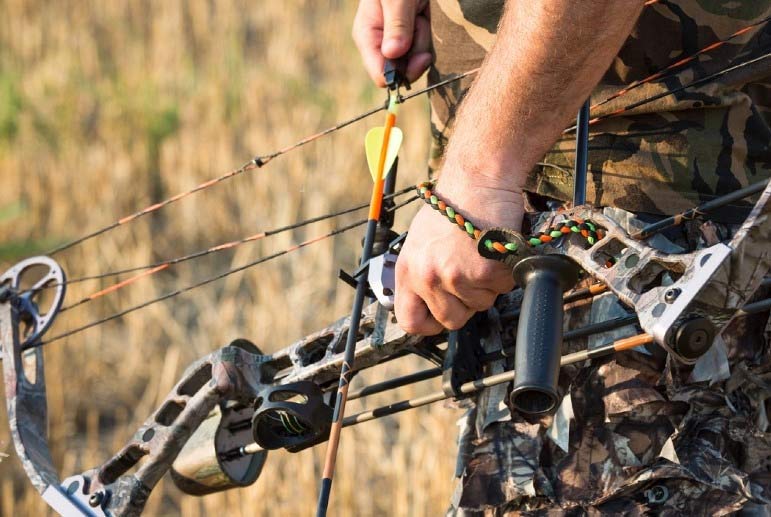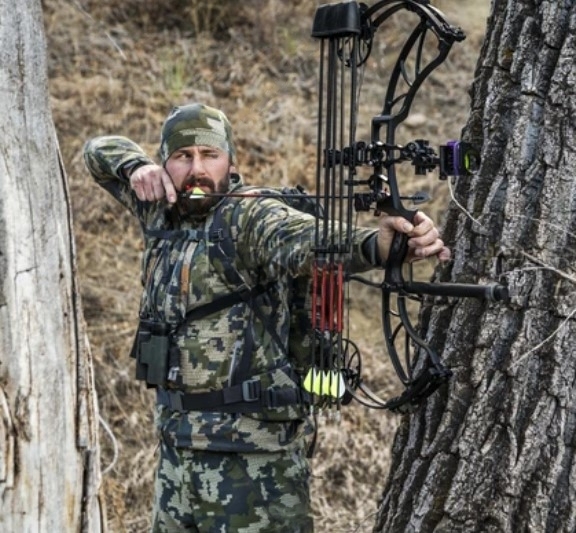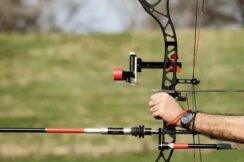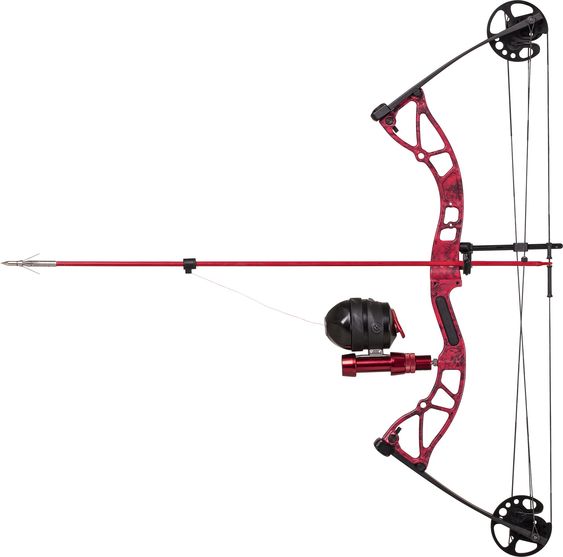Are you new to the world of archery and looking to purchase your first compound bow? Understanding the various parts of a compound bow is essential to making an informed decision and enhancing your shooting experience.
In this comprehensive guide, we will walk you through the different components of a compound bow, their functions, and how they contribute to your overall performance. So let’s dive in and explore the world of compound bow parts!

Choosing The Right Compound Bow for You
Understanding the function of each part of a compound bow can significantly aid in finding a flawless fit. Each component—riser, limbs, cams, bowstring, and more—serves a unique role in overall performance, which can be tailored to match your shooting style and preferences.
A detailed understanding of compound bow parts empowers you to make an educated choice, customizing your gear for ideal balance, power, and precision.
These components’ flexibility allows you to customize the equipment to meet your unique needs, from changing limb tension to adjusting the draw length.
Compound Bow Parts: An Overview


Before we delve into the details, let’s familiarize ourselves with the basic structure of a compound bow. A compound bow typically consists of the following parts:
1. Riser
The unsung hero of your compound bow, the riser, plays a remarkably important role in your shooting experience. Constructed from robust materials like aluminum or carbon fiber, the riser functions as the core of your bow, from which all other components diverge.
- Aluminum risers: known for durability and strength
- Carbon fiber risers: preferred for high performance, lightness, and vibration reduction
- Ergonomic design: enhances comfort and reduces hand fatigue
- impacts the bow’s balance and stability
- Accommodates the grip, limbs, and other essential parts
- Crucial to the compound bow’s overall speed and accuracy
2. Limbs
Serving as primary force generators, the limbs of your compound bow flex and store energy as you draw the string back. Their innovative design significantly contributes to your bow’s overall precision.
- Limbs are available in different flexibilities, depending on your strength and the power you need.
- The limbs are connected to the riser, and they flex as the string is drawn back.
- Greater flexibility in the limbs means storing more energy, resulting in a forceful shot when released.
- Perfectly tuned limbs help improve accuracy and tight groupings in your arrow shots.
- Different materials used in limbs, like carbon, aluminum, or fiberglass, impact performance and shooting comfort.
3. Cams
The heart of any compound bow lies in its cams, essentially the gears that make a compound bow stand apart from traditional recurve bows. These elliptical or circular devices at the bow’s tips determine draw length, power, and arrow release speed.
- Ensuring smooth, controlled arrow release
- Providing the ability to customize draw length and power
- Boosts arrow velocity considerably
- Allows for energy storage during the draw cycle.
4. Bowstrings and Cables
Bowstrings and cables, much more than just a connecting point, are vital components that transfer the tension in your compound bow. Their condition and precision impact your bow’s overall performance.
- Importance of well-maintained bowstrings and cables for effective tension transfer.
- Bowstrings and cables: key players in a compound bow’s functionality
- Impact of bowstrings and cables on your shooting accuracy.
- Role of bowstrings and cables in energy storage during the draw cycle
5. Cable Guard:
The Cable Guard prevents the bow’s cables from interfering with the arrow’s flight, reducing the risk of contact between the arrow and the cables. Such contact can disrupt the arrow’s trajectory and accuracy.
6. Bowstring silencers:
Bowstring silencers absorb and dissipate the energy that travels through the bowstring when an arrow is released. This helps make the shot quieter, which is especially important for hunters who want to minimize noise in the field.
- Vibration Dampening: By reducing the vibrations in the bowstring, silencers also contribute to a smoother and more comfortable shooting experience. This can be particularly beneficial for maintaining accuracy and comfort during prolonged target practice sessions.
7. Sight
Aim like a pro, thanks to the vitality of the compound bow sight! Its job shouldn’t be underestimated; this tiny yet mighty component can significantly improve accuracy by providing an aiming point for your shots. No two targets are the same, and this gear adjusts accordingly, making each aim precise.
The compound bow sight is small in size but huge on impact. Its role? Tuning your aim to perfection Different targets and varying distances were all mastered with the help of this piece of equipment. Its importance echoes each time an arrow strikes true, showing that a good sight can spell the difference between success and missed shots.
8. Arrow Rest
The arrow rest serves as the launching platform for your arrow. As a key part of the compound bow, its role is pivotal in guiding and propelling the arrow to your intended target with precision.
- Aids in enhancing accuracy.
- It helps maintain the arrow’s balance.
- guides the arrow’s initial flight path.
- Varieties are available for different shooting styles.
- Provides consistent shot placement.
9. Stabilizers
Stabilizers are non-negotiables for aficionados seeking the perfect balance in their compound bows. Serving dually as shock absorbers and balance propellants, they enrich your bow experience, ensuring every shot lands true.
Adding a stabilizer guarantees precision in every arrow released and longevity in your bow. It absorbs vibrations during releases, allowing for finely tuned shots that hit right on target.
The resilience that stabilizers add to your bow cannot be understated. They dampen the recoil and significantly reduce limb and string stress, significantly extending the lifespan of your beloved compound bow.
10. Quiver
A quiver is a handy accessory to hold your arrows while you’re out in the field. Quivers come in various styles, including hip quivers, back quivers, and bow-mounted quivers. Pick one that suits your needs and complements your shooting style.
The Functions of Compound Bow Parts
- Riser: The riser provides a stable platform for the archer to hold and manipulate the bow. It should be comfortable to grip and offer ample space for any additional accessories.
- Limbs: The limbs store and release energy when the bow is drawn. They determine the draw weight of the bow and contribute to its overall performance.
- Cam System: The cam system is responsible for the let-off and speed of the arrow. The design and configuration of cams affect the bow’s draw cycle, making it more efficient and user-friendly.
- String and Cables: These components transfer the energy from the limbs to propel the arrow forward. They must be durable and properly maintained to ensure smooth operation.
- Cable Guard: The cable guard prevents the cables from interfering with the arrow’s path during the shot, maintaining accuracy and consistency.
- Bowstring Silencers: Bowstring silencers reduce noise and vibration, ensuring a quiet shot while enhancing shooting comfort.
- Sight: A sight assists archers in aiming accurately by providing reference points and allowing for adjustments based on distance and windage.
- Arrow Rest: The arrow rest supports the arrow while it is drawn and keeps it in place during the release, facilitating a consistent and clean shot.
- Stabilizer: A stabilizer balances the bow, reducing vibrations and enhancing stability during the shot. It also aids in holding the bow steady while aiming.
- Quiver: The quiver provides convenient storage and easy access to arrows, keeping them secure and within reach during shooting sessions.
How Do Compound Bows Work?
Compound bows gain their unique efficiency from the intricate cooperation of parts. From the cams and bowstring to the riser and limbs, each component must synchronously perform their role to achieve optimal results. This mutual harmony of parts makes the compound bow a standout among archery gear.
The cams and bowstring power a compound bow. They pull and release tension to power and accurately guide the arrow. Adjusting string tension controls bow shooting force.
The riser stabilizes the bow while the limbs expand its energy. Strong yet light, the riser must balance the bow and resist drawing stress. Power distribution is improved with flexible composite limbs for a smoother shot.
Little things like the sight, gripper, and arrow rest matter. Their precision is improved through fine-tuning. Despite its small significance, the retractable arrow quiver reduces aim distractions.
Remember, every compound bow part affects performance. Respect and alter each aspect for a customized experience. Gear mania? Explore your compound bow and improve your archery.
Advantages of Using a Compound Bow
The intricate parts of a compound bow provide a unique edge in hunting and target shooting. Its customizable nature allows precision adjustments to fit the shooter’s personal needs, style, and comfort, optimizing performance.
With the adjustment capabilities of compound bow parts, it contributes to better shooting accuracy. The adjustable draw length, peep sights, and stabilizers can greatly enhance precision and consistency.
The compound bow’s mechanical advantage lies in its parts, which focus on speed. The efficient energy transfer from the string to the arrow by the cams results in an impressively fast arrow release.
However, success with a compound bow is not just about having the right parts; understanding how they interact is key. A careful balance of these components can lead to significant improvements in the overall bow performance, making each shot an experience!
What is The Difference Between Single-cam and Dual-cam Compound bows?
Start with easy things. Compound bows with one or more cams are faster and more accurate than recurve bows. Using cams, wires, and pulleys, they store and release energy well. The two types of these cams work in different ways.
Its name tells you what it is: a single-cam compound bow only has one cam at the bottom. This cam sets the length of the bow draw. There is a round wheel on one side and an oval wheel on the other. The oval wheel controls how hard the bow draws, and the circle wheel makes it easy to let go. Single-cam bows are known for being simple and easy to tune.
A dual-cam compound bow, on the other hand, has cams on both the top and bottom. These cams work together to control the length and force of the bow draw.
The draw cycle goes faster and smoother when the cams are in sync. People who are good at archery and want to be fast and strong use dual-cam bows.
What’s the difference? The main changes are in design and function. A single-cam bow might be best for people who are just starting out or who want something easier. This makes it easier to make and tune. Its steady, smooth release makes it easier to aim.
To Adjust The Draw Length of Your Compound Bow
- Gather the necessary tools (allen wrench or bow-specific tools).
- Locate the cam modules on your bow.
- Loosen the module screws, but don’t remove them.
- Slide the cam module along the axle to adjust the draw length.
- Consult a professional for optimal draw length, or use arm span divided by 2.5 as a rough estimate.
- Tighten module screws securely, but avoid overtightening.
- Test the adjusted draw length for comfort and natural feel.
- Seek professional guidance if uncertain about adjustments.
Conclusion
In this guide to compound bow parts for beginners, we’ve explored the key components, including the riser, limbs, cams, bowstring, and more. These parts can be customized to enhance your shooting experience. Compound bows offer advantages like customizability, efficiency, and precision.
We’ve also discussed the difference between single-cam and dual-cam bows and provided steps for adjusting draw length. Understanding these aspects will help you make an informed choice and improve your archery skills.
FAQ’s about Compound Bow Parts
Why are compound bows preferred by archers?
Compound bows are favored for their customizability, efficiency in energy transfer, and precision, making them suitable for both target shooting and hunting.
How do I adjust the draw length of my compound bow?
Adjusting draw length involves loosening cam module screws, moving the module along the axle, and securing it. Seek professional guidance for precision.
What role does the riser play in a compound bow?
The riser is the bow’s core, affecting balance, stability, and performance. Different materials, like aluminum and carbon fiber, offer various advantages.
Why are stabilizers important in a compound bow setup?
Stabilizers reduce vibrations and enhance stability during the shot, contributing to improved accuracy and shooting comfort.
What purpose does a quiver serve in archery?
A quiver is an accessory that holds arrows, providing convenience and easy access while in the field during shooting sessions.
How can I optimize the performance of my compound bow?
To optimize your compound bow’s performance, consider adjusting components like draw length, sights, and stabilizers to match your shooting style and preferences.




